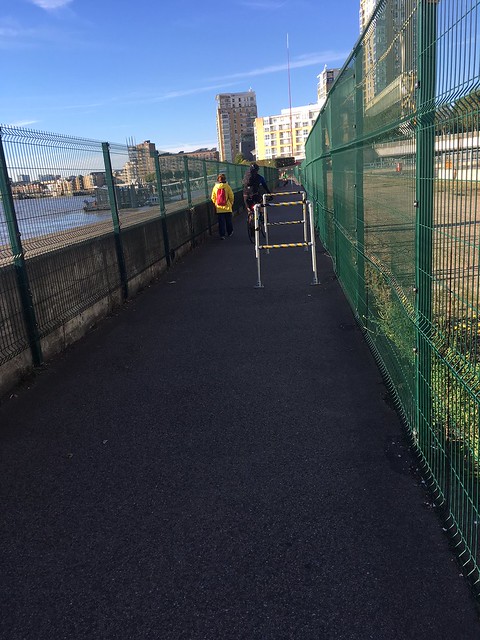-
Like so:

So, this evening the engineers (for that is how the warning sign identified them) are working on a solution.
What they've done is they've dug a hole, ~75mm deep.
Into this hole, they've rawl-bolted the flange, so that the top of the flange is level with terra -firma.
They've then attached the pipe work, and buried the flange under ~75mm of asphalt.
So plan B differs from plan A by adding ~75mm of asphalt on top of the flange.
I'm not convinced that they are actually engineers, or that their solution will be in any way effective - given the ~1200mm of leverage afforded by the pipe work.
You are reading a single comment by @user90297 and its replies.
Click here to read the full conversation.
 user90297
user90297 JurekB
JurekB
My commute takes me along here
https://www.google.co.uk/maps/@51.5044604,-0.0275999,3a,75y,108.96h,77.02t/data=!3m6!1e1!3m4!1sAF1QipO7vcyqttgmKLh7-ZWhQC13ZiYEIDm4vQnq9hFy!2e10!7i5376!8i2688
Last Friday, Canary Wharf Management (for I assume it was they) put up half a dozen chicane type barriers, to slow down cyclists - I can see why they will have done that as it is a busy pedestrian path, and some cyclists bomb along there at twuntish speeds, and the fence gives the peds nowhere to dive out of the way.
Its a less than optimal scenario.
Each chicane has 3 'gates' of tubular steel, standing about 1200mm high, bolted to terra firma using a couple of M10 rawlbolts on each leg. And they are very effective at slowing down cyclists. I actually have to hop my way around them because fixed and toe-overlap.
I think 1200mm of tubular steel must cede a fair bit of leverage on M10 rawlbolts as, this morning, each one of the barriers was missing one of its gates, rendering it wholly ineffective.
I'm guessing that at low tide, its possible to see where the missing barriers are ....... ;-)